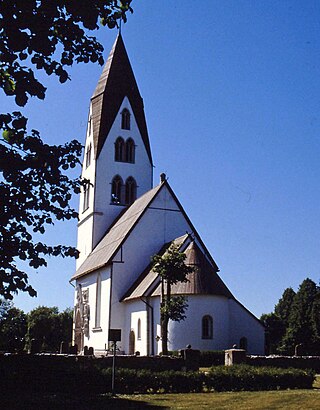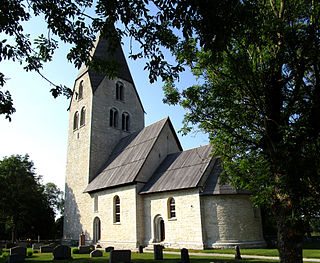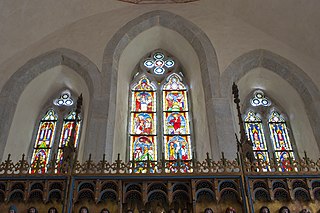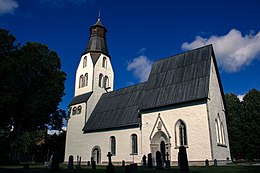
Visby Cathedral, formally Visby Saint Mary's Cathedral, is a cathedral within the Church of Sweden, seat of the Bishop of Visby. It lies in the centre of Visby, the main town on the Swedish island Gotland. It was built as the church of the German traders in the city during the 13th century. The very first church was probably a wooden church, which was later replaced by a stone building. Originally built as a basilica, it was successively expanded and rebuilt during the Middle Ages. At the end of this period it had been transformed to a hall church, which it still is. In 1361, Gotland and the church became part of Denmark. Following the Reformation, it was the only medieval church in the city left in use, and in 1572 raised to the status of cathedral. Since 1645 Gotland and the cathedral have been part of Sweden. A major renovation was carried out in 1899–1903 under the guidance of architect Axel Haig.

Garde Church is a medieval church in Garde on the Swedish island of Gotland. It was built in stages during the Middle Ages. The oldest part is the nave and the base of the tower, while the most recently constructed part is the large chancel. A large renovation was carried out in the 1960s. Garde Church together with its cemetery and its four lychgates constitute one of the most well-preserved medieval church ensembles in Sweden.

Grötlingbo Church is a medieval church in Grötlingbo on the Swedish island Gotland. The stately Gothic church contains elements of a Romanesque frieze, incorporated from an earlier church building on the same site. Görtlingbo Church lies within the Diocese of Visby.

Ala Church is a medieval church in Ala on the Swedish island of Gotland. Its oldest parts date from the 12th century. Damaged by fire in the 1930s, it still contains medieval murals and its original baptismal font. The church belongs to the Church of Sweden and lies within the Diocese of Visby.

Burs Church is a medieval church in Burs on the Swedish island of Gotland. The oldest parts of the church is the Romanesque nave, while the large choir is Gothic and richly decorated in the style of the time. Inside, the church has an altarpiece from the 15th century and a Gothic choir stall, among other things.

Stånga Church is a medieval church in Stånga on the Swedish island of Gotland. The site of the church has probably been considered sacred since before the Christianization of Scandinavia.

Hörsne Church is a medieval church in Hörsne-Bara on the Swedish island of Gotland. Dating from the 13th to the 14th century, the church has unusually richly decorated portals. It belongs to the Diocese of Visby of the Church of Sweden.

Eke Church is a medieval church in Eke on the Swedish island of Gotland. The church was built during the 12th and 13th century, with only smaller additions and changes made later. Inside, several medieval murals survive. The church is used by the Church of Sweden and lies in the Diocese of Visby.

Lärbro Church is a medieval church in Lärbro on the Swedish island of Gotland. The church is located at a former strategically important spot, as testified by the adjacent fortified tower. The presently visible Gothic church replaced an earlier Romanesque church during the 13th and 14th century. The cemetery of the church contains several graves of victims from Nazi concentration camps who were taken to a field hospital in Lärbro during and after World War II.

Barlingbo Church is a medieval church in Barlingbo on the Swedish island of Gotland. It dates from the 13th century and has been altered little since. It contains furnishings from several centuries, including an unusual medieval baptismal font, decorated with figures and runes. The church belongs to the Church of Sweden and lies in the Diocese of Visby.

Ekeby Church is a medieval church in Ekeby on the Swedish island of Gotland. The oldest parts date from the 12th century, and the church has been little altered since the end of the 13th century. Its interior is richly decorated with medieval murals. It belongs to the Church of Sweden and lies in the Diocese of Visby.

Rone Church is a medieval church in Rone on the Swedish island of Gotland. The Gothic church contains a number of medieval murals. It is part of the Church of Sweden and lies in the Diocese of Visby.

Ganthem Church is a well-preserved Romanesque church in Ganthem on the island of Gotland. It contains murals from the 15th century as well as a number of medieval furnishings. It lies in the Diocese of Visby (Sweden).

Halla Church is a medieval church in Halla on the Swedish island Gotland. It is part of the Diocese of Visby.

Mästerby Church is a medieval church in Mästerby on the Swedish island of Gotland. It is richly decorated with medieval murals. Mästerby Church belongs to the Diocese of Visby.

Stenkumla Church is a medieval church in Stenkumla on the island of Gotland, Sweden. It belongs to the Diocese of Visby. During the Middle Ages, the church was dedicated to Saint Lawrence.

The surviving amount of medieval stained glass in Sweden is relatively small, compared to some other European countries. There are in total 165 medieval stained glass panes with figurative depictions surviving in 37 churches, constituting a total area of about 60 square metres (650 sq ft), a fragment of the original amount but still the largest amount found in any of the Nordic countries. Archaeological evidence and old drawings indicate that many more once existed.

Othem Church is a medieval church in Othem on Gotland, Sweden. It was built in the 13th century and contains several medieval murals.

Hamra Church is a medieval church in Hamra, Gotland, Sweden.



























